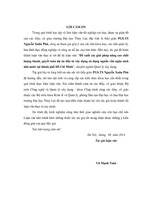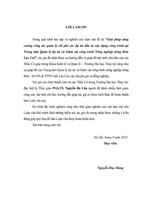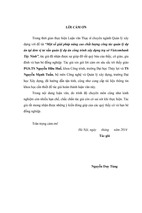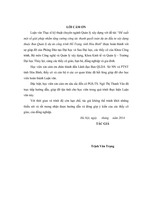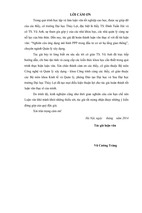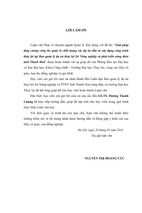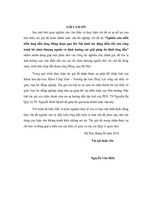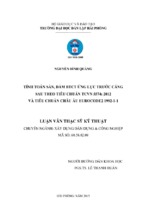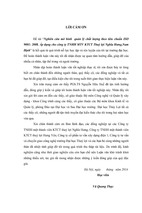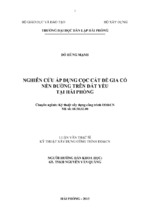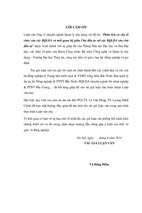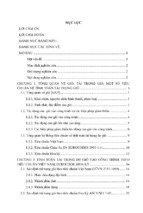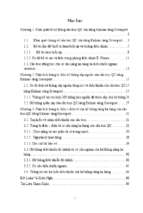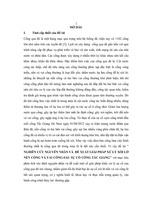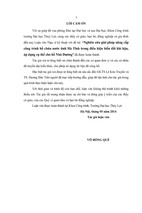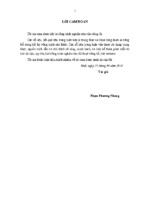BỘ GIÁO DỤC VÀ ĐÀO TẠO
TRƯỜNG ĐẠI HỌC QUẢN LÝ VÀ CÔNG NGHỆ HẢI PHÒNG
-------------------------------
ISO 9001:2015
KHÓA LUẬN TỐT NGHIỆP
NGÀNH : NGÔN NGỮ ANH
Sinh viên
: Lưu Thị Trà My
Giảng viên hướng dẫn: ThS. Nguyễn Việt Anh
HẢI PHÒNG 07– 2020
BỘ GIÁO DỤC VÀ ĐÀO TẠO
TRƯỜNG ĐẠI HỌC QUẢN LÝ VÀ CÔNG NGHỆ HẢI PHÒNG
-----------------------------------
HOW TO DEAL WITH DIFFICULTIES IN LISTENING
SKILLS FACED BY STUDENTS AT HIGH SCHOOL IN
HAI PHONG
KHÓA LUẬN TỐT NGHIỆP ĐẠI HỌC HỆ CHÍNH QUY
NGÀNH: NGÔN NGỮ ANH
Sinh viên
: Lưu Thị Trà My
Giảng viên hướng dẫn: ThS. Nguyễn Việt Anh
HẢI PHÒNG 07 – 2020
BỘ GIÁO DỤC VÀ ĐÀO TẠO
TRƯỜNG ĐẠI HỌC QUẢN LÝ VÀ CÔNG NGHỆ HẢI PHÒNG
--------------------------------------
NHIỆM VỤ ĐỀ TÀI TỐT NGHIỆP
Sinh viên: Lưu Thị Trà My
Lớp
: NA2001
Ngành
: Ngôn Ngữ Anh
Mã SV: 1612751022
Tên đề tài: How to deal with difficulties in listening skills faced by
students at high school in hai phong
NHIỆM VỤ ĐỀ TÀI
1. Nội dung và các yêu cầu cần giải quyết trong nhiệm vụ đề tài tốt
nghiệp
……………………………………………………………………………
……………………………………………………………………………
……………………………………………………………………………
……………………………………………………………………………
……………………………………………………………………………
……………………………………………………………………………
2. Các tài liệu, số liệu cần thiết
………………………………………………………………………………………………………………………………………………
………………………………………………………………………………………………………………………………………………
………………………………………………………………………………………
……………………………………………………………………………
……………………………………………………………………………
……………………………………………………………………………
……………………………………………………………………………
3. Địa điểm thực tập tốt nghiệp
……………………………………………………………………………
CÁN BỘ HƯỚNG DẪN ĐỀ TÀI TỐT NGHIỆP
Họ và tên
: Nguyễn Việt Anh
Học hàm, học vị
: Thạc Sĩ
Cơ quan công tác
: Trường Đại học Quản lý và Công nghệ Hải Phòng
Nội dung hướng dẫn: How to deal with difficulties in listening skills faced by
students at high school in hai phong
Đề tài tốt nghiệp được giao ngày 30 tháng 03 năm 2020
Yêu cầu phải hoàn thành xong trước ngày 30 tháng 06 năm 2020
Đã nhận nhiệm vụ ĐTTN
Đã giao nhiệm vụ ĐTTN
Sinh viên
Giảng viên hướng dẫn
Hải Phòng, ngày 01 tháng 07 năm 2020
HIỆU TRƯỞNG
CỘNG HÒA XÃ HỘI CHỦ NGHĨA VIỆT NAM
Độc lập - Tự do - Hạnh phúc
PHIẾU NHẬN XÉT CỦA GIẢNG VIÊN HƯỚNG DẪN TỐT NGHIỆP
Họ và tên giảng viên: ...................................................................................................
Đơn vị công tác:
........................................................................ ..........................
Họ và tên sinh viên:
.......................................... Chuyên ngành: ...............................
Nội dung hướng dẫn: .......................................................... ........................................
............................................................................................................................
1. Tinh thần thái độ của sinh viên trong quá trình làm đề tài tốt nghiệp
............................................................................................................................ ...
..................................................................................................................................
....... .........................................................................................................................
...... ..........................................................................................................................
....... .........................................................................................................................
2. Đánh giá chất lượng của đồ án/khóa luận (so với nội dung yêu cầu đã đề
ra trong nhiệm vụ Đ.T. T.N trên các mặt lý luận, thực tiễn, tính toán số
liệu…)
....... .........................................................................................................................
........ ........................................................................................................................
........ ........................................................................................................................
....... .........................................................................................................................
....... .........................................................................................................................
3. Ý kiến của giảng viên hướng dẫn tốt nghiệp
Được bảo vệ
Không được bảo vệ
Điểm hướng dẫn
Hải Phòng, ngày … tháng … năm ......
Giảng viên hướng dẫn
(Ký và ghi rõ họ tên)
QC20-B18
CỘNG HÒA XÃ HỘI CHỦ NGHĨA VIỆT NAM
Độc lập - Tự do - Hạnh phúc
PHIẾU NHẬN XÉT CỦA GIẢNG VIÊN CHẤM PHẢN BIỆN
Họ và tên giảng viên: ..............................................................................................
Đơn vị công tác:
........................................................................ .....................
Họ và tên sinh viên:
...................................... Chuyên ngành: ..............................
Đề tài tốt nghiệp:
......................................................................... ....................
............................................................................................................................
............................................................................................................................
1. Phần nhận xét của giáo viên chấm phản biện
....... .........................................................................................................................
........ ........................................................................................................................
........ ........................................................................................................................
....... .........................................................................................................................
....... .........................................................................................................................
2. Những mặt còn hạn chế
....... .........................................................................................................................
........ ........................................................................................................................
........ ........................................................................................................................
....... .........................................................................................................................
....... .........................................................................................................................
3. Ý kiến của giảng viênchấm phản biện
Được bảo vệ
Không được bảo vệ
Điểm phản biện
Hải Phòng, ngày … tháng … năm ......
Giảng viênchấm phản biện
(Ký và ghi rõ họ tên)
QC20-B19
ACKNOWLEDGEMENTS
First of all, I would like to express my sincere gratitude to my supervisor,
Mr. Nguyen Viet Anh, MA for her generous assistance, enthusiastic guidance
and constructive supervision throughout my thesis. Without her help, this
graduation paper would not have been completed.
Second, my thanks also go to other teachers of Foreign Laguage Department,
HaiPhong University of
Management and Technology for their valuable
lectures and instructions during the four years, which help me much in
completing my research.
Next, special thanks send to all the Tran Hung Dao upper secondary school
students for their enthusiasm in finishing the survey questionnaires and
interview questions
Finally, I am grateful for my family and friends who have always been beside
and encourage me during the time I carried out this study.
Hai Phong, July, 2020
Luu Thi Tra My
ABSTRACT
Listening plays a vital role in daily lives. People listen for different purposes
such as entertainment, academic purposes or obtaining necessary information.
As for foreign language learning, listening is of paramount important since it
provides the language input . Without understanding input appropriately,
learning simply can not get any improvement. In addition, without listening
skill, no communication can be achieved . As for that, language learners,
especially those who learn English as a foreign language in a non-native setting,
find it difficult to acquire good listening skill. This small project is an attempt to
identify problems faced by the Tran Hung Dao upper secondary school . This
research would concentrate on these matters below:
The way student self-study on their own
The most common problems they encounter
The strategies which help them to get over and succeed in listening
I hope that my research would bring students advantages and development to
their listening skill.
TABLES OF CONTENTS
ACKNOWLEDGEMENTS
ABSTRACT
TABLES OF CONTENTS
PART 1 : INTRODUCTION.............................................................................. 1
1.1 Rationale.......................................................................................................... 1
1.2 Aims of the study ............................................................................................ 2
1.3 Justification ..................................................................................................... 2
1.4. Objectives of the study ................................................................................... 2
1.5. Scope of the study .......................................................................................... 2
1.6. Methods of the study ...................................................................................... 2
1.7 The organization of the study ......................................................................... 3
PART 2 : DEVELOPMENT .............................................................................. 4
Chapter 1 : Literature Review Theoretical background related to English
listening skill ........................................................................................................ 4
1.1 Definition of listening ..................................................................................... 4
1.2. Types of listening ........................................................................................... 7
1.3 Listening process ............................................................................................. 8
1.4. Significance of listening ............................................................................... 10
1.5. Problems faced by students while learning listening ................................... 12
1.6. Methods of learning listening....................................................................... 15
CHAPTER 2 : RESEARCH METHODOLOGY .......................................... 22
2.1. Introdution .................................................................................................... 22
2.2. Participants ................................................................................................... 22
2.3. Resources and materials ............................................................................... 23
2.4. Instruments for collecting data ..................................................................... 23
2.5. Data collection procedures ........................................................................... 24
2.6. In conclusion ................................................................................................ 24
CHAPTER 3 : DATA ANALYSIS .................................................................. 25
3.1 Students’ attitude toward learning English in general and listening skillin 25
3.2 The students' assessment of learning the listening skill(Q2) ....................... 26
3.3 Studying on practicing listening skill of students (Q3) ............................... 29
3.4 Difficulties students encounter when listening in class(Q4)......................... 30
3.5 The factors affecting to the interest in English listening skill (Q5) .............. 31
3.6 Ways to Improve Listening Skills for students English Majors(
Q6) ...... 32
3.7 The activities students should do before and while listening in class(Q7) ... 34
CHAPTER 4 : FINDING AND DISCUSSION .............................................. 36
4.1 . Finding and discussion ................................................................................ 36
4.2. Recommendations ........................................................................................ 37
PART 3 : CONCLUSION ................................................................................ 53
1. Overview of the study ..................................................................................... 53
2. Limitation of the study. ................................................................................... 54
3. Suggestions for the further study. ................................................................... 54
REFERENCES .................................................................................................. 56
APPENDIX: Students’survey questionnaire ..................................................... 58
PART 1 : INTRODUCTION
1.1 Rationale
It could not be denied that English language in the whole world has become
more and more important. English even becomes the international language, is
used in many countries in a popular way and is the mother tongue of many
countries over the world. In fact, English is the native language of more than
350 million people and it is spoken more than any other languages. It is the
international language of different fields such as business, politics, science,
technology, banking, tourism and others. Therefore, the demand for learning
English is very great. In Vietnam as well as in other countries, there is a greater
and greater need to learn English, from young to old, and from male to female
alike. English gradually plays a vital role in Vietnam nowadays. Therefore, it is
being taught at every educational level and it has become a compulsory subject
in most schools. Being good at communication in English particularly and in
foreign languages generally is the desire of all foreign language learners.
However, it requires them to speak and to listen well in which listening seems
the most challenging task for every student. In fact, there are many factors
affecting the learners in listening acquisition. Consequently, it is very difficult
for them to master this skill. Like students from different universities, I have
faced many difficulties in listening. With four - year experience in learning the
skill and from what me observed in practicing listening of other classmates, it
can be found that many students failed in practicing listening skill. Some of
them complained that they felt unconfident with listening tasks so they could
hardly understand the spoken messages. All these above reasons have inspired I
to do research on listening skill and as a result, a research title goes as
“Difficulties of learning listening comprehension faced by Tran Hung Dao upper
secondary school
1
1.2 Aims of the study
This research attempts to explore ways employed by students while doing their
won listening. It also aims to find out difficulties as well as to provide some
recommendation for improvement.
1.3 Justification
Listening is almost ignored in both secondary and high school, where students
spent seven years in English language learning. This results in poor listening
skill when they become English major. As compared with other language skill,
listening is considered the most challenging subject. Therefore low scores in
listening are unavoidable.
1.4. Objectives of the study
The main objective of this research is as follows: To investigate English
listening problems and listening proficiency of students the grade 12
The sub-objectives of this research are as follows: To investigate the causes of
misunderstanding and misinterpreting English messages and obtain the
suggestions from the students that would help them improving their English
listening skill.
1.5. Scope of the study
The subjects of this research are limited to 12 graders program, at Tran Hung
Dao high school. 90 students will be the sample of this survey.
The instrument for the survey is a self- administered questionnaire. The
participants are asked to answer the questionnaire by themselves. The
questionnaire consists of both closed-ended and opened-ended questions.
1.6. Methods of the study
The study will be conducted using quantitative and qualitative methods. The
study includes survey questionnaires for both teachers and students, interview
questions for students only grade 12 at the Tran Hung Dao upper secondary
school. After getting the results, the researcher will use the tables and charts for
presenting the collected data.
2
1.7 The organization of the study
The study includes : 3 Parts mainly organized as follows:
Part I: Introduction deals with :Rational, Aims of the study, Justification,
Objective of the study, Scope of the study, Methods of the study, The
organization of the study.
Part II: Development
Chapter 1: Literature Review Theoretical background related to English
listening skill : Definition of listening, Type of listening, Listening process,
Significance of listening , Problems faced by students while learning listening ,
Methods of learning listening.
Chapter 2: Research methology consists of : Introdution, Participan, Resources
and materialsts, Instruments for collecting data, Data collection procedure, In
conclusion.
Chapter 3 : Data analysis discusses : The first is students’ attitude toward
learning English in general and listening skill in particular , the second is the
students' assessment of learning the listening skill, the third is studying on
practicing listening skill of students, the four is difficulties students encounter
when listening in class,in addition is the factors affecting to the interest in
English listening skill,next is ways to improve listening skills for students
English Majors, finally is the activities students should do before and while
listening in class.
Chapter 4 : Findings and discussion of findings mentions : Finding and
discussion, Recommendations
Part III: Conclusion focus : Overview of the study, Limitation of the study,
Suggestions for the further study.
3
PART 2 : DEVELOPMENT
Chapter 1 : Literature Review Theoretical background related to English
listening skill
1.1 Definition of listening
Listening plays an important role in second language instruction for
several reasons (Rost, 1994). If you cannot hear it well you will find it hard to
communicate or perhaps you cannot pass your listening examination for
instance. In fact, students often take the wrong way when listening and this leads
them to the poor result. It should be noted that the learner’s perception of their
listening problem and strategies can affect their comprehension both positively
and negatively (Wenden, 1986). Thus, in order to help students get improved
with their listening skill, it is needed finding out their listening problems which
cause difficulties to them. According to Yagang (1994), the problems in
listening were accompanied with the four following factors: the message, the
speaker, the listener and the physical setting. Furthermore, a numbers of
research have been carried out to pick out the problem in listening. The
problems were believed to cause by the speech rate, vocabulary and
pronunciation (Higgins, 1995). As Flowerdew & Miller (1996) assumed that the
problems of the students were for the speed of delivery, new terminology and
concept, difficulty in focusing and the physical environment. As Nguyen Ngoan
stated in his article “listening to VOA: advantages, problems and solutions” the
students have to face these three problems. First of all, the students find it hard
to understand proper names as they have never heard about it before. In other
words, they have no background knowledge about what they are listening. The
second problem is believed to rise from the unfamiliar, uninteresting and too
long listening which makes the students feel strange, discouraged and bored of
what they are hearing. The last one is assumed to be about the sound
connections and intonation spoken by native speakers with different accents.
The research available on second-language listening comprehension is
insufficient. Comparing with other skills, Goh (1997:161) said that “there are
4
fewer insights about the process of listening and the way it is learnt”. Similarly,
Richards (1985:189) stated that:” there is little direct research on second
language listening comprehension”. As for that, I am doing this research not
only to help students in our university with better listening but also to contribute
a small part to enrich the listening research which has been done so far.
Unlike other skills, listening needs to deal with spoken language which is
often unplanned and typically exhibits short idea units (Vandergift, 2006).
Listening takes place in real time and is ephemeral, thus a listener does not have
the option of reviewing the information and has little control over the rate of the
speech.
Despite of being a difficult concept to define in the eyes of researchers, some of
them have introduced definitions of listening from various perspectives
According to Howatt and Dakin (1974) listening is ability to identify and
understand what other are saying. This process involves understanding a
speaker‟s accent or pronunciation, the speaker‟s grammar and vocabulary, and
comprehension of meaning. An able listener is capable of doing these four
things simultaneously. Thimlison‟s (1984) definition of listening includes
“active listening”, which goes beyond comprehending as understanding the
message content, to comprehension as an act of empathetic understanding of the
speaker. Ronald and Roskelly (1985) define listening as an active process
requiring the same skills of prediction, hypothesizing, checking, revising, and
generalizing that writing and reading demand; and these authors present specific
exercises to make students active listeners who are aware of the „inner voice‟
one hears when writing.
Purdy (1991) defined listening as “the active and dynamic process of attending,
perceiving, interpreting, remembering and responding to the expressed verbal
and nonverbal needs, concerns and information offered by the human beings.”
Carol( 1993) described listening as a set of activities that involve “the
individual‟s capacity to apprehend, recognize, discriminate or even ignore”.
Rubin(1995) conceived listening as “ an active process in which a listener
5
selects and interprets information which comes from auditory and visual clues in
order to define what is going on and what the speakers are trying to express.”
For Imhof(1998), listening is “ the active process of selecting and integrating
relevant information from acoustic input and this process is controlled by
personal intentions which is critical to listening”. Reviewing listening studies
done in the past decades, Buck (2001) wrote that listening us a personal and
individual, and a series of process which begin with deciphering incoming
sounds and later make meaning out of them. Recently, Rost (2002) sated
“listening = experiencing contextual effects” which can be translated as
“listening as a neurological event (experiencing) overlaying a cognitive event
creating a change in a representation”.
There
have
been
different
definitions
of
the
term
“listening
comprehension.” According to Semiotician Roland Barthes: “Hearing is a
physiological phenomenon, listening is a psychological act. “Hearing is always
occurring, most of the time subconsciously. In contrast, listening is the
interpretative action taken by the listener in order to understand and potentially
make meaning out of the sound waves. Listening can be understood on three
levels: alerting, deciphering, and an understanding of how the sound is produced
and how the sound affects the listener (Barthes, Roland (1985) In the
Responsibility of Forms, New York Hill and Wang). Listening is the ability to
identify and understand what others are saying. This process involves
understanding a speaker’s accent or pronunciation, speaker’s grammar and
vocabulary, and comprehension of meaning. An able listener is capable of doing
these four things simultaneously (Saricoban, 1999). Definition of listening is
also simplified is the activity of receiving, evaluating and understanding
something we hear. Arguing that what is successful listening, Anderson and
Lynch (1988) also defined: “Understanding is not something that happens
because of what a speaker says: the listener has a crucial part to play in the
process, by activating various types of knowledge, and by applying what he
knows to what he hears and trying to understand what the speaker means” (P6)
6
Today, we realize that listening is a process acquiring people to be active and a
listener is a good one when being active. To be well in listening, listeners must
have the capability of analyzing and deciphering the massage sent, and the
ability of applying strategies and skills to get meaning, and the ability to make
the replying in many ways, basing on the content, the theme and the aim of the
conversation. Listening also strongly relates to thoughts, emotions and
intentions. In conclusion, listening is a process of identifying and understanding
what the speakers say, which includes understanding a speaker’s pronunciation,
grammar and vocabulary. Listeners have to know how to conduct and do the
process under the circumstance in an active way, not make listening viewed as a
passive process.
1.2. Types of listening
Wolvin and Coakly (1988, 1993) have introduced a categorization of listening.
They identified 5 types of listening: Discriminative Listening , Comprehensive
Listening , Therapeutic Listening , Critical Listening and Appreciative
Listening.
Discriminative listening is where the objective is to distinguish sound andvisual
stimuli. This objective does not take into account the meaning; instead the focus
is largely on sounds. In a basic level class, this can be as simple as
distinguishing the gender of the speaker or the number of the speakers etc. As
mentioned before the focus is not on comprehending; but on accustoming the
ears to the sounds. If one thinks she/he can see that this is where listening
begins - the child responds to sound stimulus and soon can recognize its parents'
voices amidst all other voices. Depending on the level of the students, the
listening can be discriminating sounds to identifying individual words.
Then, there is Comprehensive listening which the focus is on 'understanding the
message'. The writers consider this as the basis for the next three types of
listening. However, the problem can come in the form of 'understanding'.
Depending on many factors, (both individual and social) students can end up
understanding the same message in different, different ways. Most of work in
7
teaching listening in the classroom has to happen here in facilitating the students
to develop their comprehension skills.
The third one - Therapeutic listening - is one kind of listening where the
listener's role is to be a sympathetic listener without much verbal response. In
this kind of listening the listener allows somebody to talk through a problem.
This kind of listening is very important in building good interpersonal relations.
Critical listening is the fourth kind of listening, in which listeners have
toevaluate the message. Listeners have to critically respond to the message and
give their opinion.
The final one is Appreciative listening which the focus is on enjoying what one
listens. Here, some students raised the point that when they listen to English
music, even if they don't understand, they still enjoy thereby challenging the
notion of comprehensive listening as the basis for other three types of listening.
Then we reflected on the practice of listening to songs in the language lab.
Generally those students listen to the songs once and try to make out the lyrics
before listening a second time with the lyrics. Then they recalled that they
appreciated the song better during the second time and were able to see the
relation between how one would enjoy something that she/he is able to make
sense of.
In this way, the discussion of the five types of listening turned out to be quite
informative and thought provoking for all underscoring the adage when one
1.3 Listening process
Listening process divides into five periods:
8
Hearing
Responding
Filtering
Comprehension
Remembering
Chart 1.1. Five periods in listening process
Hearing - Filtering- Comprehension - Remembering - Responding
Hearing: Hearing is the first essential step in the listening process and relates to
the sensory perception of sound. The listener further processes the perceived
sound. For learning to be effective, hearing needs to be done with attention and
concentration.
Filtering: The next step involves sensing and filtering of heard sounds. The
heard message is categorized as wanted or unwanted, useful or useless. The
unwanted message is discarded. In this step, the sense of judgement of the
individual comes into play, that is, the filtering process is subjective and a
person chooses to retain what makes sense to him.
Comprehending: The next level of listening consists of comprehending or
understanding. The listener understands or interprets what the speaker has tried
to convey. This activity can be described as absorbing, grasping or assimilating.
In order to grasp the meaning of the message, the listener uses his knowledge,
9
- Xem thêm -




